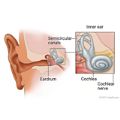Test Overview
Electronystagmography (ENG) measures normal eye movement and involuntary rapid eye movements called nystagmus. It also checks the muscles that control eye movements. ENG checks how well the eyes, inner ears, and brain help you keep your balance and position (such as when you change from lying down to standing).
ENG is done to help see whether there is damage or a problem in how the inner ear, brain, or nerves connecting them work. These problems may cause dizziness, vertigo, or loss of balance.
Nystagmus occurs normally when the head is moved. But nystagmus without moving your head or nystagmus that does not go away may be caused by conditions that affect the inner ear, brain, or the nerves connecting them.
During ENG, electrodes are attached to the face near the eyes to record eye movements. The movements are recorded on graph paper. A series of recordings is done.
- Baseline recordings are taken with your head at rest.
- More recordings are done:
- While you move your head up and down, left and right.
- While you look at a moving object.
- After warm or cold water (or air) is placed inside your ears.




